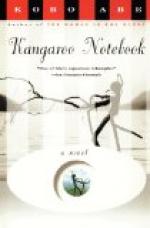|
This section contains 6,477 words (approx. 22 pages at 300 words per page) |

|
SOURCE: "Water, Ships, and the Sea: Unifying Symbols in Lawrence's 'Kangaroo'," in The University Review, Vol. XXXVII, No. 1 October, 1970, pp. 46-57.
In the following essay, Samuels surveys the maritime symbolism of D. H. Lawrence's novel Kangaroo, seeing in the work's sea imagery the irresistible forces of nature, society, and the unconscious.
There is running through Kangaroo, a sustained symbolic language, other than that used simply to describe the Australian landscape, which connects artistically the various elements of its central theme—the relationship of the individual to his inner self, to other individuals, and to his world. All of these relationships, both in Somers' present and in his past, are represented symbolically and allegorically through descriptions of water, ships, and the sea.
Richard Lovat Somers' first reaction to Australia is negative. Spanning the wide Pacific which separates him from his native land is a "long navel string fastening him...
|
This section contains 6,477 words (approx. 22 pages at 300 words per page) |

|


